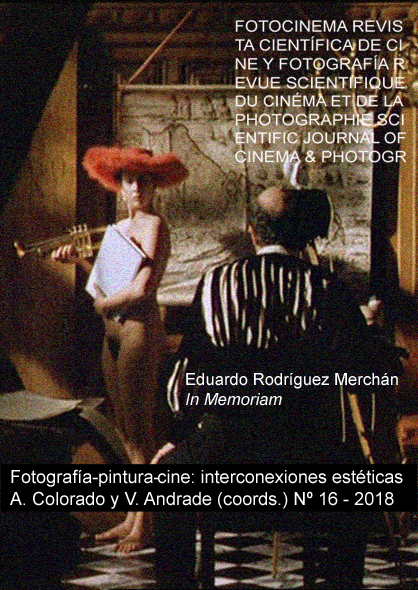The invention of landscape in the photograph by Claudia Jaguaribe
DOI:
https://doi.org/10.24310/Fotocinema.2018.v0i16.4091Keywords:
Paisagem, Arte contemporânea, Crise da representação, História da Arte, História da Fotografia, paisaje, arte contemporáneo, crisis de la representación, História del Arte, História de la FotografíaAbstract
This article discusses the construction of the landscape in the photographic series Entre Morros (2010) and Over São Paulo (2011) by Brazilian visual artist Claudia Jaguaribe. The formal and visual analysis of these works intends to highlight the discussions proposed by Jaguaribe on the change in the natural and constructed landscapes and the procedures by means of which the artist makes the image enunciate otherwise the real and problematize the landscape as representation in either the story of the painting and of photography. Such analysis will be held in the context of two relevant discussions in the fields of communication and of art today: the regime of images in which mimesis is no longer a major enunciative regulator and the landscape as a problem of representation of space in contemporary photography. Based on contemporaries theories of landscape in art history, history of photography and in cultural geography, the text will seek to link the artist's production to the construction of landscape images in painting and photography through the panoramas and pictorialists' photomontage. In so doing, I intend to demonstrate how landscape emerges as a problem of representation since the nineteenth century, anticipating some of the issues raised by contemporary art.
Downloads
Metrics
Publication Facts
Reviewer profiles N/A
Author statements
Indexed in
-
—
- Academic society
- N/A
- Publisher
- Universidad de Málaga
References
Benjamin, W.(2011) Origem do Drama Barroco Alemão. Belo Horizonte: Autêntica.
Burgi, S. (2012). O construído e o documental. En Entre Morros. São Paulo: Cosac Naify. s/n.
Crary, J. (2012). Técnicas do observador. Rio de Janeiro: Contraponto.
Cauquelin, A. (2009). A invenção da paisagem. São Paulo: Martins Fontes.
Cosgrove, D. (2008). Introduction to Social Formation and Symbolic Landscape. En Landscape Theory. (pp. 17-42) New York and London: Routledge.
Didi-Huberman, G. (2015) Diante do tempo. Belo Horizonte: Editora da UFMG.
Fernandes, M. A. (2012) Fotomontagem no Século XIX: da mecânica à narratologia. En Revista Rhêtorikê. Disponible: http://www.rhetorike.ubi.pt/04/pdf/Rhetorike-04-03-fernandes.pdf
Fried, M. (2012). Why Photography matters as art as never before. 4th ed. New Haven and London: Yale UP.
Galassi, P. (1981). Before Photography. Painting and the invention of Photography. New York: The Museum of Modern Art.
Lissovsky, M. (2011). A paisagem e a proveniência dos lugares. En Revista Contemporanea. Disponible: https://portalseer.ufba.br/index.php/contemporaneaposcom/article/view/5053/3890.
Mitchell, W.T (Ed). (2002) Landscape and power. Chicago and London: The Chicago UP.
Poivert, M. (2010). La Photographie Contemporaine. Paris: Flammarion.
Ranciere, J. (2009). A partilha do sensível: estética e política. Rio de Janeiro: Ed. 34.
Downloads
Published
How to Cite
Issue
Section
License
All contents published in Fotocinema Revista científica de cine y fotografía are protected under the Creative Commons Attribution-NonCommercial-ShareAlike 4.0 International (CC BY-NC-SA 4.0) license. All about this license is available in the following link: <http://creativecommons.org/licenses/by-nc-sa/4.0>
Users can copy, use, redistribute, share and exhibit publicly as long as:
- The original source and authorship of the material are cited (Journal, Publisher and URL of the work).
- It is not used for comercial purposes.
- The existence of the license and its especifications are mentioned.
There are two sets of authors’ rights: moral and property rights. Moral rights are perpetual prerogatives, unrenounceable, not-transferable, unalienable, imprescriptible and inembargable. According to authors’ rights legislation, Fotocinema. Revista científica de cine y fotografía recognizes and respects authors moral rights, as well as the ownership of property rights, which will be transferred to University of Malaga in open access. The property rights are referred to the benefits that are gained by the use or the dissemination of works. Fotocinema. Revista científica de cine y fotografía is published in an open access form and it is exclusively licenced by any means for doing or authorising distribution, dissemination, reproduction, , adaptation, translation or arrangement of works.
Authors are responsable for obtaining the necessary permission to use copyrighted images.














13.png)



